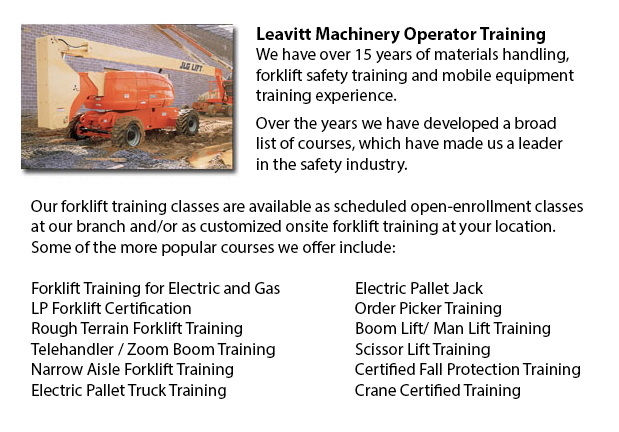
Kitchener Aerial Boom Lift Ticket - Aerial lifts can be utilized to accomplish several different duties performed in hard to reach aerial places. A few of the duties associated with this style of jack include performing regular preservation on buildings with prominent ceilings, repairing telephone and power cables, lifting heavy shelving units, and pruning tree branches. A ladder could also be used for many of the aforementioned jobs, although aerial hoists offer more security and strength when properly used.
There are many versions of aerial lifts existing on the market depending on what the task needed involves. Painters often use scissor aerial lifts for example, which are grouped as mobile scaffolding, of use in painting trim and reaching the 2nd story and above on buildings. The scissor aerial hoists use criss-cross braces to stretch and extend upwards. There is a table attached to the top of the braces that rises simultaneously as the criss-cross braces elevate.
Container trucks and cherry pickers are a different type of aerial lift. They possess a bucket platform on top of a long arm. As this arm unfolds, the attached platform rises. Lift trucks utilize a pronged arm that rises upwards as the lever is moved. Boom hoists have a hydraulic arm that extends outward and lifts the platform. All of these aerial lifts require special training to operate.
Through the Occupational Safety & Health Association, also called OSHA, training courses are on hand to help make sure the employees satisfy occupational values for safety, machine operation, inspection and repair and machine weight capacities. Workforce receive certification upon completion of the classes and only OSHA certified workers should run aerial hoists. The Occupational Safety & Health Organization has established rules to maintain safety and prevent injury when utilizing aerial lift trucks. Common sense rules such as not using this machine to give rides and making sure all tires on aerial hoists are braced in order to prevent machine tipping are mentioned within the guidelines.
Sadly, statistics show that in excess of 20 operators pass away each year while running aerial hoists and 8% of those are commercial painters. Most of these incidents are due to inappropriate tire bracing and the lift falling over; for that reason a lot of of these deaths were preventable. Operators should make certain that all wheels are locked and braces as a critical safety precaution to prevent the machine from toppling over.
Other guidelines involve marking the encircling area of the device in an obvious way to protect passers-by and to guarantee they do not come too close to the operating machine. It is vital to ensure that there are also 10 feet of clearance between any electrical cables and the aerial lift. Operators of this machinery are also highly recommended to always wear the appropriate safety harness while up in the air.
-
Kitchener Forklift Training Schools
Kitchener Forklift Training Schools - The Advantages Of Taking One Of Our Forklift Training Schools Are you searching for work as a driver of a forklift? Our regulatory-compliant mobile equipment operator training offers instruction in types of fo... More -
Kitchener Overhead Crane Operator Training
Kitchener Overhead Crane Operator Training - Our overhead crane operator training course is designed to teach employees the basics of overhead crane/sling operation and pre-shift checks. Courses are taught by our expert trainers and consultants. Well... More -
Kitchener Crane Training School
Kitchener Crane Training School - The crane training school offers industry-relevant programs. Courses provide trainees with learning outcomes which match present industry demands. Our small class sizes combine hands-on experience and theory. Our qua... More -
Kitchener Skid Steer Ticket
Kitchener Skid Steer Ticket - The lift arms on the skid-steer loader are located at the side of the driver along with pivots behind the driver's shoulders. These features makes the skid-steer loader different as opposed to the conventional front load... More -
Kitchener Manlift Operator Certification
Kitchener Manlift Operator Certification - Our scissor platform and aerial lift training and certification empowers participants with a knowledge and general understanding of the efficient and safe use of "Power Operated Mobile Work Platforms," under... More -
Kitchener Crane Safety Training
Kitchener Crane Safety Training - Companies and crane operators have to be aware of the problems related to crane safety. Legislation provides rules for the safe operation, inspection and maintenance of lifting machines all around North America. Cran... More -
Kitchener Forklift Training Programs
Kitchener Forklift Training Programs - Are you searching for work as a forklift driver? Our regulatory-compliant mobile equipment operator training offers instruction in kinds of forklifts, pre-shift check, fuel kinds and dealing with fuels, and safe... More -
Telehandler Training in Kitchener
Telescopic handlers often known as telehandlers for short, are an extremely popular piece of heavy construction machinery. They are commonly used in the construction and agricultural industries. These equipments have extreme reaching ability and can... More

Forklift Certification Kitchener
TOLL FREE: 1-888-254-6157
Kitchener, Ontario
forkliftcertificationkitchener.com
Email Us
About Us


